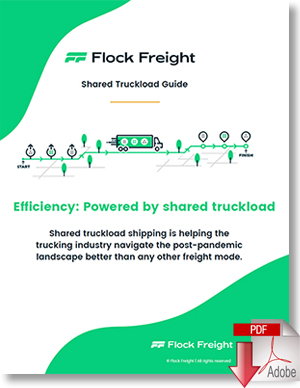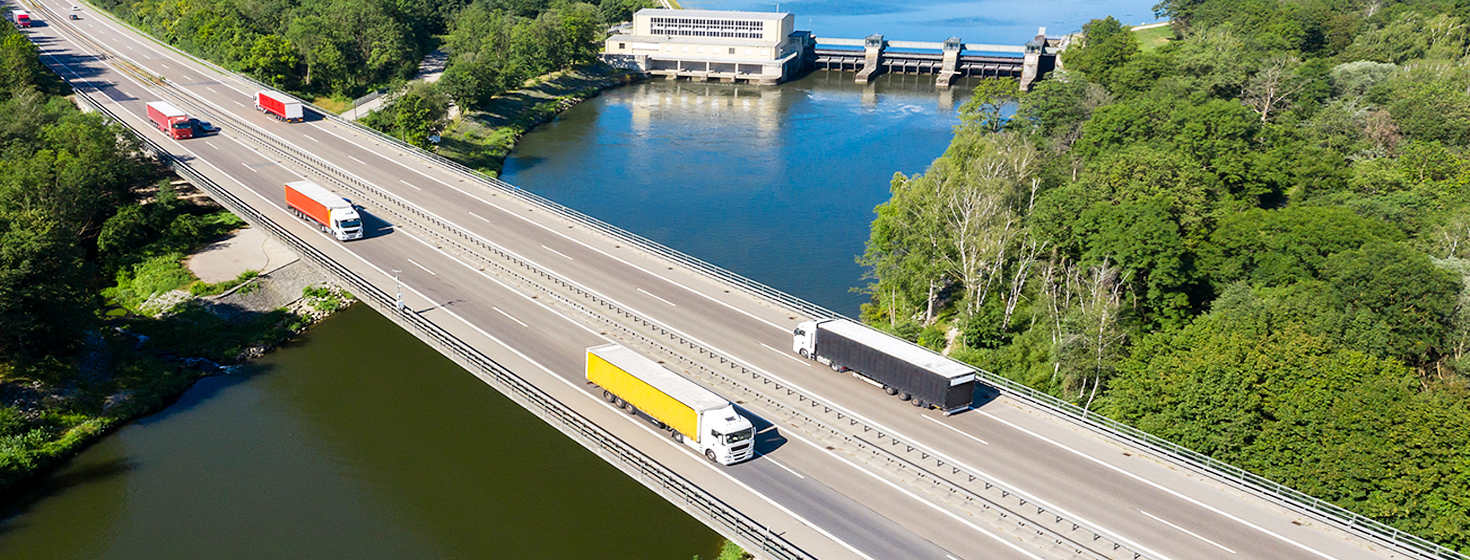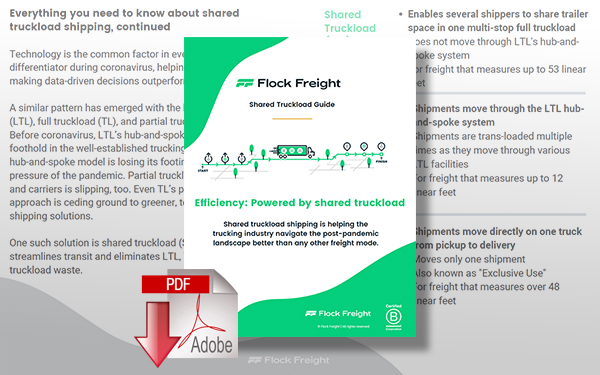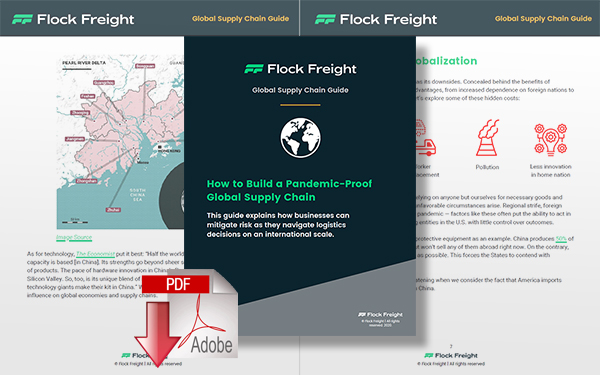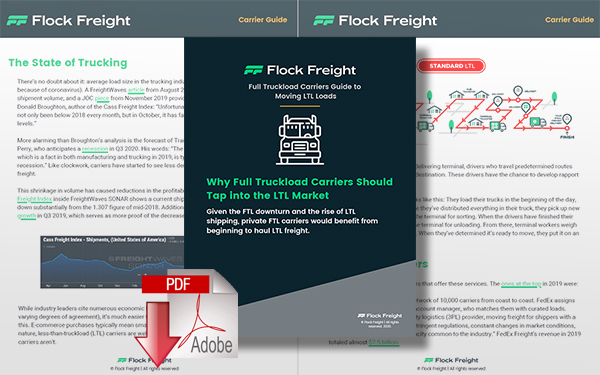Why Shared Truckload is a Better Solution for Shippers and Carriers When Moving Freight

By helping shippers and carriers move freight on their own terms, shared truckload pulls ahead of the less-than-truckload and full truckload methods.
Adjusting Your Daily Freight Operations
If you’re a shipper, you may dedicate an enormous amount of resources to produce your products and ship them to their final destinations.
Even though technology and other modern advancements have streamlined supply chains, transportation doesn’t always go as planned.
In the age of coronavirus, you may have had to contend with business slowdowns (and, consequently, the inefficiency of shipping less freight) or sudden demand for your products (and accelerated shipping schedules as a result).
Either way, you’ve most likely had to adjust your daily operations.
If you’re a carrier, you move as many profitable loads within your preferred regions as possible.
Like shippers, you may have had to recalibrate your business model because of coronavirus.
During the pandemic, authorities classified trucking as essential and obligated truck drivers to reckon with the risk of catching COVID-19 on the front lines.
Additionally, March, April, May, and June’s volatile freight volumes lowered shipping rates across the industry, posing profitability challenges for carriers.
Read the Article: What Does A Coronavirus Pandemic Recovery Look Like For The Trucking Industry?
To stay afloat, many carriers laid-off workers to reduce payroll expenses.
Those that didn’t close or declare bankruptcy are still trying to raise profits with new contracts and consistent loads.
Whether you’re a shipper or a carrier, you’re optimizing your company’s shipping logistics for today’s unpredictable landscape.
One decision you have to make is which freight mode to leverage: Shared truckload (STL), less-than-truckload (LTL), or full truckload (TL).
Innovation Gives Shared Truckload an Edge
Shared truckload, a freight mode that enables several shippers to share trailer space in one multi-stop full truckload, takes a familiar concept (sharing) and applies it to the trucking industry to help shippers and carriers create optimal shipping outcomes.
By giving shippers the power to decide how their freight moves and incentivizing carriers to travel efficiently, the shared truckload approach flips the outdated freight system on its head and offers a revolutionary alternative.
With shared truckload service, shipments that are traveling on a similar route move on the same truck.
Freight travels directly from its pickup location to its destination - without passing through hubs or terminals - and isn’t handled during transit.
Plus, you don’t have to meet any freight class requirements or a weight minimum.
Accommodating loads of almost any size, shared truckload service is the ideal solution for shipments that measure up to 48 linear feet and contain one to 24 pallets.
This transformative approach provides shippers, carriers, and the planet with more benefits than any other mode, including:
For Shippers
- Minimal handling to keep freight intact
- Full truckload service to prevent lost freight
- Direct transit along an efficient route to deliver freight on time
- Shared trailer space for cost savings of 20% or more
For Carriers
- The ability to fill trucks to capacity with loads that pay more than standard one-pick, one-drop freight
- Optimized routes that don’t take you out of your way
- (For TL carriers) Access to the LTL freight market, which has less TL competition and more loads to choose from than the TL market
For the Environment
- Optimized, shared truck space to eliminate wasted fuel and unnecessary trips
- Streamlined travel that reduces greenhouse gas emissions by up to 40%
- Hubless transportation to take carbon-intensive and energy-consuming LTL terminals out of the equation
- Less need to remanufacture and reship goods that had been previously damaged in LTL facilities
To summarize, shared truckload service provides shippers with the same TL service that they know and love at a fraction of the price, and carriers with higher earning potential and untapped business opportunity.
In addition, shared truckload is the only freight mode that’s designed to reduce the trucking industry’s carbon footprint.
The other two shipping modes, LTL and TL, just can’t compete with a shared truckload.
Terminal Stops Prove to be a Liability for LTL
LTL, a freight mode that zigzags shipments through the outdated hub-and-spoke system, is wasteful in its approach. Why use eco-unfriendly terminals when you could transport shipments directly?
By transloading freight at multiple facilities during transit, the LTL method gives shippers something they never asked for: Increased handling.
To make matters worse, freight moves slower with LTL service than it does with shared truckload service.
So why is LTL service popular?
- Most small- and medium-size businesses need to move loads that don’t fill trucks to capacity, and LTL shipping helps them do that
- It’s less expensive than TL service
- Many carriers offer it
- There hasn’t been a better way to deliver loads from several shippers in one trip - until now
In terms of load size, the LTL mode caters to shipments that are less than 4,000 pounds or six pallets and don’t fill a full-size truck to capacity. Freight class plays an important role in LTL service, dictating how goods travel and influencing shipping prices.
Unfortunately, LTL service puts shippers, carriers, and the environment at a disadvantage with:
For Shippers
- Damage
- Misplaced freight
- Late deliveries
For Carriers
- High barriers to entry (The LTL market is dominated by a small number of large LTL carriers.)
- Higher risk of contracting COVID-19 working in the hub-and-spoke network than hauling shared truckload freight
For the Environment
- Annual carbon emissions in the United States of 342 million tons, which would fall by 136.8 million tons every year if America’s LTL industry scrapped the hubs and used shared truckload service instead
- Inefficient trips that pass shipments from one truck driver to another and emit more pollutants than necessary
- Wasted energy on forklifts and other equipment that unloads and reloads freight at LTL facilities
- Excessive carbon use by hubs and terminals
- Repeated resource consumption for replacement goods that were previously damaged during transit, then remanufactured and reshipped
LTL service is more trouble than it’s worth. Even TL shipping, which doesn’t have as many cons as LTL shipping, loses to the shared truckload mode.
TL Loses Ground Because of its Limitations
TL, a shipping mode in which one truck moves freight from a single shipper directly from the pickup location to the drop-off location, has limited functionality. With TL shipping, trucks move no matter how much freight they’re hauling. Established companies are typically the only ones that can afford such an indulgent service.
The TL mode usually transports freight that weighs 15,000 or more pounds and includes more than 10 pallets on a full-size truck, regardless of freight class.
If TL and LTL are the only options, shippers that have more freight than is cost-effective to book LTL yet not enough to fill an entire trailer face a tough decision: Pay a premium for extra LTL space, pay for air on a TL deck, or wait to ship the load until there’s enough freight to fill a whole truck. And shippers know better than anyone that waiting doesn’t fly when demand is high.
Other cons to TL shipping include:
For Shippers
- Highest price tag
- No-load optimization (The only way to make the most of your dollar is to fill the entire truck.)
For Carriers
- Hauling freight for one shipper pays less than doing the same job for multiple shippers
- The TL market doesn’t give you access to the LTL loads that top off your truck and increase your profitability
For the Environment
- Annual carbon emissions in the United States of 836 million tons
- Moves air all too often, which means several trucks might end up doing a job that one could handle
- Wasted resources from unused truck space
While the TL mode offers faster shipping than LTL service, shippers can get the same efficiency of TL service for less money with shared truckload shipping. STL service does shippers one better by optimizing transit for loads of almost any size, which TL service can’t promise.
In The End, Shared Truckload Comes Out On Top
The mode that a shipper selects becomes an extension of its supply chain. The mode that a carrier moves determines its revenue potential. A shared truckload is the best mode no matter which lens you’re looking through. It guarantees TL service at a better rate for shippers and helps carriers earn more per mile.
By maximizing deck space with freight from more than one shipper, shared truckload also eliminates the pitfalls of the un-green hub-and-spoke model, facilitates streamlined transportation, and minimizes the trucking industry’s environmental impact. These benefits are invaluable, especially at present.
Flock Freight is the only logistics provider that offers shared truckload shipping. In addition to providing the benefits above, Flock Freight’s shared truckload solution, FlockDirect, gives shippers control over their pickup and delivery dates and carriers a dedicated support team.
To date, Flock Freight has completed over 13,000 shared truckload shipments and saved over 660 metric tons of fuel emissions with its FlockDirect service.
Related Article Shared Truckload Services: Smarter Shipping for Optimizing the Modern Freight World
Related Resources
Efficiency: Powered by Shared Truckload
In this guide, we take a deep dive into how shared truckload shipping is helping the trucking industry navigate the post-pandemic landscape better than any other freight mode. Download Now!
How to Build a Pandemic-Proof Global Supply Chain
This guide explains how businesses can mitigate supply chain risk, including the latest coronavirus pandemic, as they navigate logistics decisions on an international scale. Download Now!
Why Full Truckload Carriers Should Tap into the LTL Market
In this Full Truckload carriers Guide to moving LTL loads, we discuss the FTL downturn and the rise of LTL shipping, and how private FTL carriers would benefit from beginning to haul LTL freight. Download Now!
More Resources from Flock Freight
Article Topics
Flock Freight News & Resources
Wasted Space and Damaged Freight Overshadowed Favorable Conditions for Businesses in 2022 Top Issues Affecting Shippers Last Year 6 Lessons from CSCMP EDGE 2022 to Improve Shipping Freight & Supply Chain Inefficiencies Inefficiency - Not Just the Labor Shortage - Is Breaking Supply Chains Today’s Post-Pandemic Parcel Delivery Marketplace A Shipper’s Guide to Navigating Post-Pandemic 2022 Holiday Freight Shared Truckload Freight Increases Carrier Revenue by 20% More Flock FreightLatest in Transportation
Ranking the World’s 10 Biggest Supply Chains The Top 10 Risks Facing Supply Chain Professionals Walmart’s Latest Service: Ultra Late-Night Delivery City of Baltimore Files Lawsuit to Recoup Money for Collapsed Bridge The Era of Self-Driving Tractor-Trailers Set to Begin Is the Trailers as a Service (TaaS) Model Right For Your Business? Why Grocery Shoppers are Leaving Stores to Buy Their Food Online More Transportation

